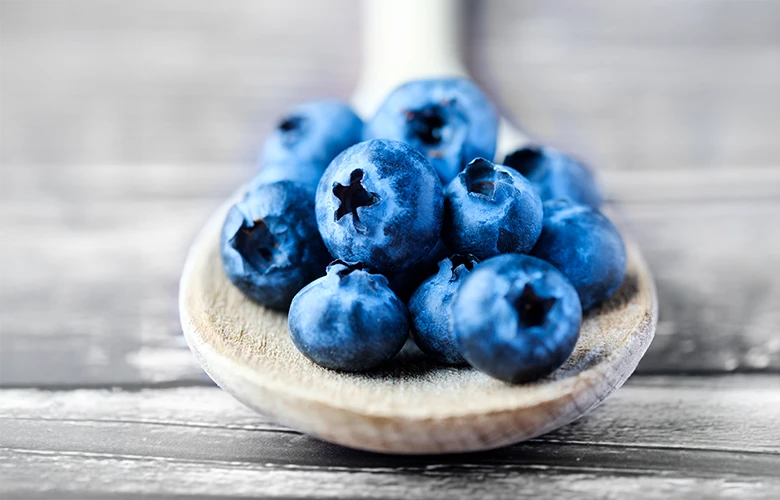I can’t wait to share with you a little miracle of nature, and a delicious one at that!
I spoiled myself with my title, so there’s no need to drag out the suspense…
It’s all about blueberries!
What’s so great about this healthy fruit?
Because of the polyphenols it contains, in particular anthocyanin (another strange name). But what else?
Blueberries have a significant antioxidant action (they trap free radicals), giving them anti-aging properties.
At cardiovascular level, they are highly protective, as they also have vasodilatory properties. In other words, they open up arteries, veins and capillaries to improve blood circulation, and protect their walls.
In concrete terms, regular consumption of :
- Contributes to lowering blood pressure
- Reduces the risk of myocardial infarction by a factor of 3 with 3 or more servings of bilberry per week! *
Anthocyanin also has an anti-inflammatory action.
Combined with the activities mentioned above, this makes it an excellent cerebral protector.
So it’s ideal for young people to boost memory and concentration, and for the not-so-young to improve cognitive function and help prevent neurodegenerative diseases such as Parkinson’s and Alzheimer’s.
And that’s not all!
Regular consumption of bilberries also reduces the risk of type 2 diabetes** .
Researchers have attributed a reduced risk of all-cause mortality to blueberry anthocyanins***.
It should also be noted that they have a preventive action through numerous anti-cancer mechanisms, notably epigenetic ones ****
And that’s not all: bilberries have a prebiotic effect, i.e. they pamper our microbiota.
And the icing (no, blueberry) on the cake is that they give us a little boost when it comes to our weight: regular consumption promotes lean body mass gain and fat loss (or how to clear your conscience by eating a slice of blueberry tart ?lol ).
And what’s more, they boost our glow…. What else?!
So convinced ????
To benefit from its many virtues, we recommend consuming 1 portion of 30 to 50g (a good handful) 3 times a week, fresh or frozen (equivalent to 300mg-600mg/d anthocyanins).
If you can’t find blueberries today, don’t panic!
Although blueberries (especially wild ones) are the berries with the highest anthocyanin content, other fruits also contain anthocyanins: blackberries, pomegranates, raspberries, strawberries and grapes (I’ve listed them in order of highest to lowest anthocyanin content).
Fruit juices are less concentrated than fresh fruit. Of particular interest is pomegranate juice (more on this in another article, as it’s my personal favorite).
And as it’s not summer all year round, think about frozen fruit!
However, don’t combine them with milk (no milkshakes!) as this reduces the absorption of the famous anthocyanins.
So, to boost your health, all you have to do is add blueberries to your life…
Bibiographical references:
- *High anthocyanin intake is associated with a reduced risk of myocardial infarction in young and middle-aged women
Aedín Cassidy 1, Kenneth J Mukamal, Lydia Liu, Mary Franz, A Heather Eliassen, Eric B Rimm
https://pubmed.ncbi.nlm.nih.gov/23319811/ - ** : Dietary flavonoid intakes and risk of type 2 diabetes in US men and women
Nicole M Wedick 1, An Pan, Aedín Cassidy, Eric B Rimm, Laura Sampson, Bernard Rosner, Walter Willett, Frank B Hu, Qi Sun, Rob M van Dam
https://pubmed.ncbi.nlm.nih.gov/22357723/ - ***: Association of flavonoid-rich foods and flavonoids with risk of all-cause mortality
Kerry L Ivey 1, Majken K Jensen 1, Jonathan M Hodgson 2, A Heather Eliassen 3, Aedín Cassidy 4, Eric B Rimm 1
https://pubmed.ncbi.nlm.nih.gov/28606222/ - **** : Anthocyanins and their role in cancer prevention
Li-Shu Wang1 and Gary D. Stoner1,* Author information Copyright and Li
https://www.ncbi.nlm.nih.gov/pmc/articles/PMC2582525/


